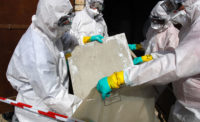From Fordham University's new law school to Columbia University's Manhattanville campus, the higher education sector, particularly in New York City, has remained strong even during the recession. The trend is expected to continue for years to come, said speakers at ENR New York's Higher Education conference, held on Oct. 16 in New York City.

The city has some 500,000 higher education students—more than anywhere else in the U.S., Laura Gallo, senior vice president and COO of the New York Building Congress, told attendees, quoting from the group's latest analysis. The city's 105 institutions of higher learning invested a total of about $4.2 billion in construction starts from 2008 through 2013, representing about 5% of all public and private construction starts throughout the city.
Academic institutions accounted for $2.8 billion of the total construction starts, and medical colleges made up $1.4 billion. From 2013 through 2017, starts are forecast to total $9.85 billion, she adds.
Most new students have grown up during the digital age and expect their schools to be suitably equipped, speakers said. Besides adding housing and classrooms, schools are expanding or retrofitting space for state-of-the-art technology as well as science, technology, engineering and math studies, in support of the city's aim to be a STEM hub.
The trend is evident especially in well-funded private institutions, such as Columbia, Fordham and New York University. All have massive building programs under way.
Major projects elsewhere in the state include the $375-million University at Buffalo School of Medicine and Biomedical Sciences. The project, which is currently that city's largest construction project, is being built by a joint venture of LiRo and Gilbane Building Co. and is set for completion in December 2016.
On the public side, the City University of New York has about $3 billion to spend over the next few years and across all of its schools. CUNY's projects include City College's $350-million Advanced Science Research Center in Manhattan, which is about to open.
"The good news is that [money] is being spent. The bad news is, we need more," said Risa Honig, assistant director at CUNY's department of design, construction and management. "When the market was in a downturn, CUNY was booming and able to design and get funding for many projects. We experienced good bids, so many of our projects are under construction or nearing completion."
Now, however, the school has many projects stuck in design because of funding shortfalls, she adds.
Speakers said schedules have become vitally important, with less opportunity to take facilities offline, which costs schools revenue and dampens recruiting.
"Architects need to be aware of that early on so when they specify things, they're working in that universe," said Vincent Burke, Fordham's director of capital projects and planning. Construction managers need to have a strong relationships with their subcontractors and materials suppliers, he adds.
Other issues in New York City include materials and labor costs, which are expected to rise 3% or 4% annually for at least the next two years.
New York City
Luxury Condos Help to Foster Work Boom
Luxury residential tower construction is helping to boost New York City construction spending levels back to where they were during industry's 2007 and 2008 peaks, according to a new study by the New York Building Congress (NYBC).
The city's 2014 residential-sector spending alone is expected to reach $10.9 billion—nearly a third of the $32.9-billion industry total forecast for the year, according to the latest NYBC forecast. If residential spending reaches that amount, it will be up about 60% from 2013.
However, the number of new dwelling units produced is expected to rise just 22% to 22,500 this year, increasing to only 23,250 in 2015, the study shows. By comparison, industry produced 33,200 housing units in 2008 with a construction spending price tag of $5.9 billion, says the group in its New York City Construction Outlook 2014-2016 report.
"Such a wide disparity between spending and production is partially explained by a wave of so-called ultra-luxury condominium towers that are being planned and built in Manhattan," said Frank J. Sciame, New York Building Foundation chairman. "While any and all new housing stock is certainly welcome, the key to the city's future success will rest in part on our ability to produce a wide range of housing at multiple price points throughout the five boroughs."
City megaprojects that broke ground this year include the first phase of the $1-billion Flushing Commons residential mixed-use development project in Queens.
While the city's 2014 total construction spending is up 17% over 2013, when adjusted for inflation it falls about 17% below the 2007 peak in terms of volume of work delivered. In 2015, it is expected to drop about 13% below that peak activity, NYBC says.
A continued strengthening in the commercial and government sectors is also contributing to total industry activity, NYBC says. Government spending is expected to rise in 2014 to $14.3 billion, from $13.4 billion in the prior year. Non-residential is set to dip slightly to $7.8 billion, from $8 billion in 2013.
NYBC forecasts 123,000 construction jobs in the city this year, up from 120,900 in 2013. It expects 125,100 jobs in 2015 and 127,300 in 2016. If the latter holds true, 2016 would be the second-highest level of industry employment in at least two decades, behind the 132,600 jobs in 2008.


Post a comment to this article
Report Abusive Comment